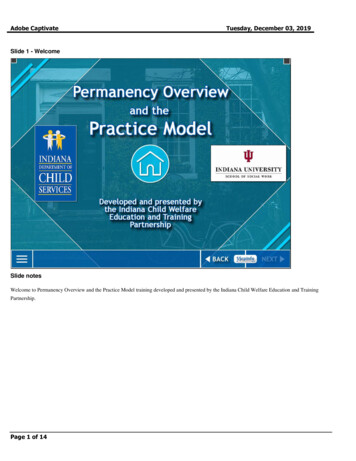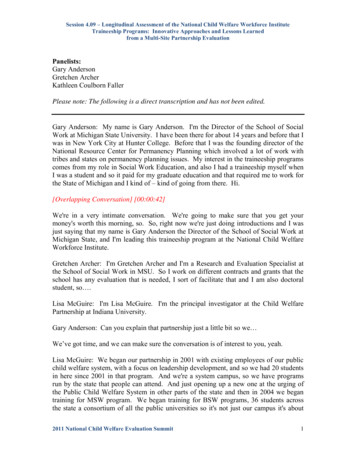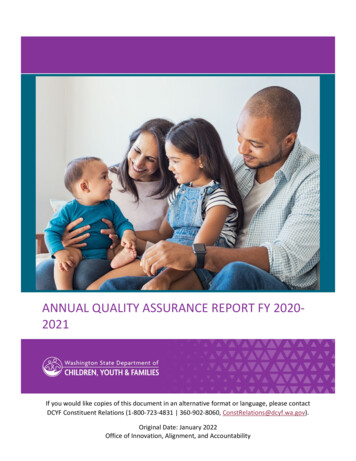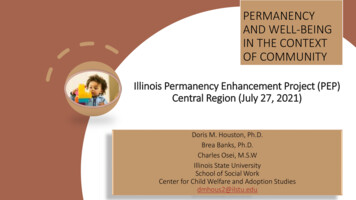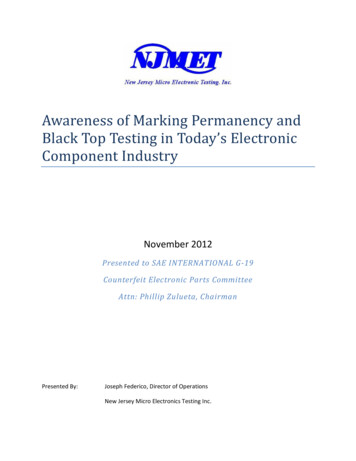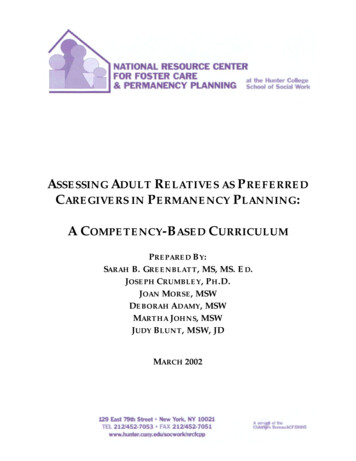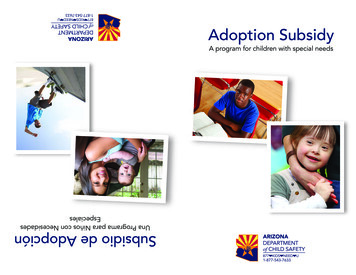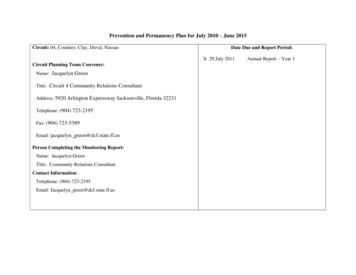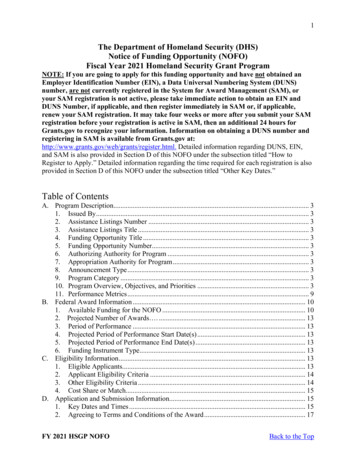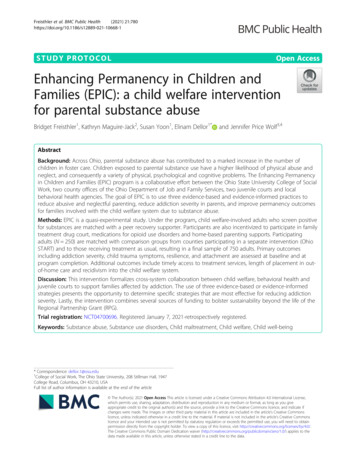
Transcription
Freisthler et al. BMC Public Health(2021) UDY PROTOCOLOpen AccessEnhancing Permanency in Children andFamilies (EPIC): a child welfare interventionfor parental substance abuseBridget Freisthler1, Kathryn Maguire-Jack2, Susan Yoon1, Elinam Dellor1*and Jennifer Price Wolf3,4AbstractBackground: Across Ohio, parental substance abuse has contributed to a marked increase in the number ofchildren in foster care. Children exposed to parental substance use have a higher likelihood of physical abuse andneglect, and consequently a variety of physical, psychological and cognitive problems. The Enhancing Permanencyin Children and Families (EPIC) program is a collaborative effort between the Ohio State University College of SocialWork, two county offices of the Ohio Department of Job and Family Services, two juvenile courts and localbehavioral health agencies. The goal of EPIC is to use three evidence-based and evidence-informed practices toreduce abusive and neglectful parenting, reduce addiction severity in parents, and improve permanency outcomesfor families involved with the child welfare system due to substance abuse.Methods: EPIC is a quasi-experimental study. Under the program, child welfare-involved adults who screen positivefor substances are matched with a peer recovery supporter. Participants are also incentivized to participate in familytreatment drug court, medications for opioid use disorders and home-based parenting supports. Participatingadults (N 250) are matched with comparison groups from counties participating in a separate intervention (OhioSTART) and to those receiving treatment as usual, resulting in a final sample of 750 adults. Primary outcomesincluding addiction severity, child trauma symptoms, resilience, and attachment are assessed at baseline and atprogram completion. Additional outcomes include timely access to treatment services, length of placement in outof-home care and recidivism into the child welfare system.Discussion: This intervention formalizes cross-system collaboration between child welfare, behavioral health andjuvenile courts to support families affected by addiction. The use of three evidence-based or evidence-informedstrategies presents the opportunity to determine specific strategies that are most effective for reducing addictionseverity. Lastly, the intervention combines several sources of funding to bolster sustainability beyond the life of theRegional Partnership Grant (RPG).Trial registration: NCT04700696. Registered January 7, 2021-retrospectively registered.Keywords: Substance abuse, Substance use disorders, Child maltreatment, Child welfare, Child well-being* Correspondence: dellor.1@osu.edu1College of Social Work, The Ohio State University, 208 Stillman Hall, 1947College Road, Columbus, OH 43210, USAFull list of author information is available at the end of the article The Author(s). 2021 Open Access This article is licensed under a Creative Commons Attribution 4.0 International License,which permits use, sharing, adaptation, distribution and reproduction in any medium or format, as long as you giveappropriate credit to the original author(s) and the source, provide a link to the Creative Commons licence, and indicate ifchanges were made. The images or other third party material in this article are included in the article's Creative Commonslicence, unless indicated otherwise in a credit line to the material. If material is not included in the article's Creative Commonslicence and your intended use is not permitted by statutory regulation or exceeds the permitted use, you will need to obtainpermission directly from the copyright holder. To view a copy of this licence, visit http://creativecommons.org/licenses/by/4.0/.The Creative Commons Public Domain Dedication waiver ) applies to thedata made available in this article, unless otherwise stated in a credit line to the data.
Freisthler et al. BMC Public Health(2021) 21:780IntroductionBackgroundA significant proportion of children in the UnitedStates are exposed to substance-using parents, withprior estimates suggesting 12% of children live in ahousehold where at least one parent is abusing ordependent on alcohol or other drugs [1]. Childrenexposed to parental substance misuse experience higherrisks for any array of physical, cognitive, psychological,and social harms [2]. Some of these adverse consequences are likely due to parental drug abuse ordependence being associated with a higher likelihood ofchild physical abuse or neglect, particularly when theperpetrator is a biological parent [3, 4].While no conclusive national estimate of the numberof children entering the child welfare system due toparental substance use exists, an estimated 1 in 5 children live in a home with an adult who misuses drugsand alcohol [5]. Caseworkers estimate that 50–80% ofparents on their caseloads have problems with substanceuse and that their children are more likely to enter fostercare [6–8]. The Fourth National Incidence Study ofChild Abuse and Neglect found that drug use was a factor in 9.5% of cases of abuse and 12.5% of all neglectcases [4]. Parents with a diagnosed substance use disorder are more likely to be physically abusive, commitchild neglect, and have a higher child abuse potentialthan those without a diagnosed substance use disorder[9, 10]. In fact, children in these families are two timesmore likely to be at risk for child maltreatment [11].This evidence is especially relevant in Ohio, which hasthe highest rates heroin and synthetic opioid-relateddeaths in the country [12]. Between 2016 and 2017,Ohio saw an 18.4% increase in the rate of drug overdoses due to prescription opioid misuse. In 2017, therewere 46. 3 opioid-related deaths per 100,000 people,more than double the national rate of 13. 3 deaths per100,000 [12]. While the national rate of heroin overdosedecreased between 2016 and 2017, at 9. 2 deaths per100,000 persons, the rate of heroin deaths in Ohioremains significantly higher than the national rate of 5deaths for every 100,000 Americans [12].These trends have overwhelmed Ohio’s child welfaresystem. Fifty percent of children placed in state custodywere due to parental substance use, with nearly half(28%) due to opioid use [13]. Consequently, the numberof children placed in custody increased by 11% [13].Need for servicesFairfield and Pickaway are adjacent counties in centralOhio. As of the 2010 census, Fairfield County had a population of 146,156, largely composed of Whites (90. 2%),with Blacks representing 6.0% of the population.Page 2 of 9Southwest of Fairfield is Pickaway County, with a muchsmaller population of 55,698. Whites make up 94.5% ofthe population followed by Blacks at 3.4%. Both countieshave high rates of opioid-addicted families involved withthe child welfare system. The rate of investigations forchild maltreatment in Fairfield County is above the stateaverage at 48.09 per 1000 children [14]. Though the rateof child maltreatment investigations is lower in PickawayCounty (14.29 per 1000), the number of children in outof-home care rose over 200% from 23 in 2013 to 73 in2018 [14, 15]. According to a survey conducted by thePublic Children Services Association of Ohio (PCSAO),79% of families involved in Fairfield County Children’sServices and 67% of families in Pickaway County ChildrenServices have identified substance use problems, bothhigher than the state-wide average of 50% [16]. In Pickaway County, all the substance-involved families were dueto opioid (including heroin) misuse, while 58% of all casesin Fairfield County involved opioids [16]. These rates areover twice the state average of 28% [16]. Thus, while opioid addiction is a particular concern, all types of substanceuse are affecting children involved in the child welfaresystem.The two county agencies have seen a significantincrease in the number of children on their caseloads.This increase is attributed to the increase in parentalsubstance abuse and has contributed to a higher numberof children in foster care and rising foster care costs. In2013, Pickaway County Children Services placed 10children in foster care in contrast, a total of 46 childrenwere placed in foster care in 2018 [16]. In FairfieldCounty, the overall number of children in agencycustody has remained steady from previous years, yetthe costs to house these children has increased dramatically due to the needs of the children. In 2014, theagency spent 1.6 million on out-of-home placementcosts, by 2018, the cost to house the same average number of children jumped to nearly 3.1 million [14].Many of these children are placed with relatives whomay be ill-equipped to address the specific needs of children exposed to substance use problems. As there arelimited non-relative foster homes available, children areoften placed several hours away from the agency creating challenges for staff to meet face-to-face requirementsand provide regular visitation between parents andchildren.Rationale for studyBoth counties have taken significant steps to addressthe needs of families, including the implementation ofOhio START (Sobriety, Treatment, and ReducingTrauma) [17].Fairfield and Pickaway counties also have FamilyTreatment Drug Courts (FTDC) in operation. FTDC
Freisthler et al. BMC Public Health(2021) 21:780includes frequent court hearings, judicial monitoring,substance abuse treatment, drug testing, and rewardsand sanctions linked to parental compliance with serviceplans [18]. However, only six residential or intensiveoutpatient substance use providers are located withinthe boundaries of the two counties, with only one providing residential or detoxification facilities. While a31bed facility recently opened in Pickaway county [19],the demand for detoxification beds still outweighs thecurrent supply. Fairfield County has little infrastructureto support the use of medications for opioid use disorders (MOUD) and has not used it systematically forchild welfare families. Further, while service providersand local governments tend to think in terms of countylines, families do not use that same thought processwhen seeking help. In this way, the patchwork structureof alcohol and other drug (AOD) services inhibits theability of both counties to address the AOD needs offamilies involved in the child welfare system.Funded by the federal Regional Partnership Grant(RPG) Program, the Enhancing Permanency inChildren and Families (EPIC) is a partnershipbetween child welfare, juvenile count court and behavioral health, to holistically address substance misuse and associated parenting needs of child welfareinvolved families.Methods / designThe overall goals and objectives of the intervention are:1. Increase timely access to services among substancesabusing parents involved in the child welfare systemin Fairfield and Pickaway counties1.1 Develop procedures to coordinate servicesbetween the child welfare system, substance abuseand behavioral health providers, and juvenile/familycourt in a specified single MOU.1. 2 Conduct substance abuse and trauma-exposurescreening and assessment within 30 days of enteringthe child welfare system.1. 3 Reduce the wait time between referral toservices and initiation of substance use andbehavioral health services.2. Enhance child safety and improve permanency2.1 Reduce length of stay in out-of-home placementfor children in EPIC program compared tosubstance-affected families not receiving EPIC.2. 2 Increase rates of reunification among familiesinvolved in EPIC compared to substance-affectedfamilies not receiving EPIC.2. 3 Reduce recidivism for child welfareinvestigations and re-entries into foster care amongparents receiving EPIC compared to substanceaffected families not receiving EPIC.Page 3 of 92.4 Identify which intervention componentsimplemented via EPIC were more likely to increasepositive outcomes for families.3. Increase child, parent, and caregiver well-being3.1 Decrease substance use/abuse addiction severityamong parents and the percentage of parentscompleting substance abuse treatment whomaintained abstinence post-treatment.3. 2 Reduce trauma symptoms experienced bychildren.3. 3 Increase resilience and attachment in children.3.4 Increase knowledge about trauma-exposureamong kinship caregivers.3.5 Improve parenting among kinship caregivers.Study componentsEPIC participants are incentivized to participate in (1)family treatment drug court (FTDC), with medicationsfor opioid use disorders (MOUD); (2) peer recovery support and (3) home-based parenting supports based onthe Nurturing Parenting Program [20].FTDC with MOUDFTDC is considered the most effective intervention toimprove substance abuse treatment initiation andcompletion in child welfare populations [21]. Parentswho participate in FTDC are more likely to enter substance use treatment, get into treatment quicker, stay intreatment longer, and complete treatment more often[22–24]. Additionally, families who complete FTDC aremore likely to be reunified with their children as compared to parents who do not participate [22–25]. To bolster the effects of FTDC, EPIC participants also haveaccess to MOUD, which has been shown to reduce withdrawal symptoms, lower the risk of relapse, address cravings, and provide medical supervision for individualsstruggling with addiction [26]. Further, MOUD is associated with an increased likelihood that children will remain in their parents’ custody [27].Peer recovery supporters—also called “recovery coaches”— are advocates for parents and their primaryfocus is to help get parents into treatment and supportthem so that they stay there. Peer recovery supportersare certified by the Ohio Department of Mental Healthand Addiction Services [28] and must complete 40 h ofin-person training, 16 h of online training, and pass atest. They are individuals who formerly had substanceuse issues, but have been clean and sober for at least3 years. Peer recovery supporters provide comprehensiveclinical assessments, service planning, referral, advocacy,case management, and outreach services. Peer recoverysupporters have had great success in reducing substanceuse and improving child welfare outcomes. Peer recoverysupporters improve access to substance use treatment,
Freisthler et al. BMC Public Health(2021) 21:780decrease time children spend in out-of-home care, increase the odds of reunification, decrease maltreatmentrecidivism, and reduce racial disparities in reunification[29–31]. Under EPIC, peer recovery supporters aretrained and supervised by two partner behavioral healthagencies, Ohio Guidestone and Integrated Services. Peerrecovery supporters make individual or joint home visitswith child welfare caseworkers and are otherwise available via phone and text as needed. They also attendmulti-disciplinary child welfare team meetings to provide expert consultation on cases.The third and final component of EPIC is parentingsupport (Relational Skill Building) based on the Nurturing Parenting Program (NPP) [20]. NPP focuses onparental expectations of children, empathy toward children’s needs, alternatives to corporal punishment, appropriate parent-child roles, and children’s power andindependence [32]. Under EPIC, the program is furtherenhanced with modules specific to substance use. Forexample, unexpected challenges related to administeringnaloxone, a drug that is used to revive individuals whohave overdosed on opioids and for kinship caregivers,ways to maintain safe relationships with biologicalparents. Under EPIC, parents and kinship caregiversmay participate in the home-based relational skillbuilding intervention.Participant recruitment, eligibility and group assignmentParticipants are recruited from Fairfield and PickawayCounty Children Services. The overall case flow is provided in Fig. 1. Within 7 days of the initial child welfareinvestigation, parents complete the UNCOPE assessment, a universal screening tool for substance useadministered to all parents entering the child welfaresystem [33]. Parents who score a 3 or higher on theUNCOPE, are considered eligible for EPIC and receive adrug screen. Eligible parents are alternated into EPIC,OhioSTART or treatment as usual (TAU). Ultimately,assignment to EPIC is determined based on caseload,but is typically offered to every third case in Fairfieldcounty and every other case in Pickaway county. Parentswho consent to EPIC are connected to peer recoverysupporters who mentor parents through the process.Parents are also referred to FTDC with the option toreceive MOUD, and lastly when children are placed athome with parents or with kinship caregivers, relationalskill building services that include financial assistancefor child care, respite and transportation services. EPICparticipants receive substance abuse and behavioralhealth treatment services through local providers including from two partner agencies: Integrated Services forBehavioral Health and Ohio Guidestone.To incentivize participation in FTDC, parents receivea 200 gift card upon completing their substance abusePage 4 of 9assessment and an additional 200 retails gift card forevery 3 months they remain involved with the court.Parents may consent to one or all three components ofEPIC based on the specific needs of each family, however all parents receive intensive case managementservices, including frequent home visits from caseworkers and peer recovery supporters. All proceduresinvolving human participants were approved by TheOhio State University’s Institutional Review Board(#2018B0001).Consent and withdrawal from studyChild welfare caseworkers obtain written informed consent and release of information from all parents at intakeprior to study enrollment. Kinship caregivers consent fortheir own participation. Participation is voluntary andparticipants are free to withdraw from the study at anytime without consequences to their child welfare cases.Collaboration, coordination and cross-trainingChild welfare-involved parents with substance use disorders must navigate multiple systems including behavioralhealth, and juvenile/family courts in order to completecase plans. To facilitate collaboration and coordinationof services for EPIC, all partner agencies entered intoone comprehensive memorandum of understanding(MOU) to jointly administer and implement EPIC. Allpartner agencies further agreed to use the Needs Portal[34], a hybrid web-based resource and referral and Management Information System (MIS), as the organizingbody for communication around each case. The NeedsPortal is used to create referrals for services, track datesof service provision, and record responses to theUNCOPE and trauma screening and assessment tools.The system works by opening a ‘ticket’ for each casewhich allows caseworkers to complete substance abuseand trauma assessments and indicate essential information about service requests. Service providers respond torequests and indicate when services have been initiatedand peer recovery supporters are able to log visits withparticipants, all within the same environment. Caseworkers, service providers, and the evaluation team cansee this information. Lastly, the Needs Portal providesdifferential access to the system based on the role of theprovider to limit access of information based on a person’s assigned role in the case (i.e., caseworker, therapist,peer recovery supporter).Prior to implementation, partner agencies alsoreceived cross-system training such that child welfareworkers become more knowledgeable of substance misuse and trauma-informed care, peer recovery supportersunderstand the child welfare system and processes, andfamily drug court coordinators and MOUD providershave a thorough understanding of the child welfare
Freisthler et al. BMC Public Health(2021) 21:780Page 5 of 9Fig. 1 Enhancing Permanency in Children and Families (EPIC): Case Flow. Parents complete the UNCOPE assessment within 7 days ofsubstantiated report of child abuse or neglect. Parents receive a drug screen if they self-identify on the UNCOPE or a caseworker suspectssubstance use. Parents who screen positive are eligible for EPIC and are 1) linked to a peer recovery supporter, 2) referred to family treatmentdrug court, with the option of medications for opioid use disorders, and 3) receive in-home parenting based on the Nurturing ParentingProgram. Participants work with assigned caseworkers to determine the most appropriate combination of services
Freisthler et al. BMC Public Health(2021) 21:780system. Representatives from each system are also members of a Steering Committee that meets every otherweek, to resolve any implementation related problemsand address barriers.Evaluation designTo evaluate EPIC, a quasi-experimental design will beemployed through a two-stage sampling procedure. Thisdesign provides the ability to assess (1) the effects ofEPIC on access to services for the families in the twointervention counties, and (2) the independent effects ofadditional services provided under EPIC that may beover and above interventions provided by Ohio STARTand treatment as usual (TAU). In the first stage, twocomparison counties will be identified for each of thetwo intervention counties. One comparison county willbe part of the Ohio START program while the secondwill be a county that has no major interventions to address substance use among child welfare families. Counties are matched based on child population size, rate ofchild protective services referrals, percent of naloxoneadministrations per adult population, percent white, percent poverty, child welfare tax levy, and to the extentpossible, behavioral health service availability. Duringthe second stage, EPIC families (N 250) are matchedwith substance using families in Ohio START (N 250)and those receiving treatment as usual (N 250).Outcome measuresAll outcome measures are assessed at baseline and againat 6 months.Sample characteristicsTo describe the sociodemographic characteristics of participants, all surveys include demographic information(e.g., biological sex, age, race/ethnicity, nativity). Inaddition, a clinical description of the sample will be provided using the 10-item Center for EpidemiologicalStudies-Depression (CES-D) scale for depressive symptoms [35], the Perceived Stress Scale (PSS) [36] and perceived availability of social support using theInterpersonal Support Evaluation List (ISEL) [37].Timely access to services is measured using dates of substance abuse screenings, trauma assessments and treatment service provision recorded in the Needs Portal.Child safety and permanency outcomes are operationalized as (1) the number of days in out-of-home care, (2)whether the family re-unifies in out of home care and(3) the number of new child welfare referrals occurringafter the initial referral that led to program participationusing administrative child welfare data from the statewide automated child welfare information system(SACWIS).Page 6 of 9Parent and child well-being outcomesAddiction severity is measured using the drug andalcohol use items in the Addiction Severity Index-SelfReport (ASI-SR) [38]. Trauma symptoms in children aremeasured using the Children’s Trauma AssessmentCenter (CTAC) trauma screening checklist [39]. TheCTAC—separately for children ages 0–5 and 6–18)—can be administered by clinicians and child welfare caseworkers in evaluating children for exposure to traumaand trauma-related symptoms. The effect of sensoryprocessing on functional performance among children0–6 months and 7–17 months is measured using version1 and 2 respectively of the Infant Toddler SensoryProfile (ITSP) [40], behavioral and emotional problemsin younger children (18 months to 5 years) and in schoolage children and adolescents (6 to 18 years) are measured using the Child Behavior Checklist (CBCL) [41]and parenting skills is measured using the 40-item AdultAdolescent Parenting Inventory, version 2 (AAPI-2)[42]. The AAPI-2 breaks down into five parentingbehavior subscales: expectations of children, parentalempathy towards children’s needs, use of corporal punishment, parent-child family roles, and children’s powerand independence. Lastly, resiliency and attachment aremeasured using the Protective Factors Survey [43].Data sources and data collection proceduresData are available from three different sources: 1) theNeeds Portal, 2) SACWIS archival data, and 3) EPICsurvey data. Needs Portal data are used to track fidelityindicators in real benchmark dates over the course ofimplementation. SACWIS data are obtained quarterlyfrom Ohio Department of Job and Family Services(ODJFS) via an encrypted password-protected USB drive.This is administrative data that are routinely collected aspart of the investigative and intervention process resulting from a referral for a child abuse and neglect investigation. The final source of data are EPIC family surveysadministered at the time of enrollment and again at 6 to12 months following program completion. Parentscomplete the survey for themselves and for one focalchild. Respondents receive a 25 gift card for completingeach survey.Statistical planBaseline descriptive statistics including sociodemographic characteristics, addiction severity and childwelfare allegations will be provided for EPIC participantsand comparison groups. For continues variables, meansand SDs will be provided and for categorical variables,counts and percentages are provided.Due to the likelihood of censored measures whenfamilies are still involved in the child welfare system,survival analysis will be utilized to assess program effects
Freisthler et al. BMC Public Health(2021) 21:780on length of stay in out of home care. Logistic regressions will be used to estimate the relationship betweenactivities and family was reunification, subsequent childmaltreatment investigations, and subsequent child maltreatment substantiations. A series of linear regressionswill be used to estimate the relationship between ouroutcome measures and various independent variables(e.g., age, biological sex). Additionally, a paired samplest-test will be conducted to examine the changes inmean scores in child, parent and caregiver well-beingoutcomes (e.g. ASI or CBCL) between baseline and6-months follow-up.Power analysisWe performed a series of power analyses using G*Power[44] and for each analytic method. Assuming a smalleffect size of 0. 2, we will be able to reject the null hypothesis with probability (power) of 1.00 (survival analysis, N 750), 0.81 (logistic regression, N 750), 0.88(paird t-tests; N 250) and 0.99 (linear regression, N 250). The Type I error probability associated with thesetests is 0.05. A detailed report is presented in Additionalfile 1.Patient and public involvementThe design of this intervention did not involve patients,however, the public’s experiences navigating the childwelfare and behavioral health systems was central to formulating research questions, outcome measures as wellas the choice of evidence-based or evidence informedpractices selected. The activities conducted as part ofEPIC is of interest to partners and other public childwelfare agencies in Ohio and across the United States.To that end we maintain a dissemination website(https://u.osu.edu/epic/) that acts as a central repositoryof information and resources.DiscussionThe EPIC program addresses current deficiencies in substance abuse treatment services for child welfare involved parents by creating an inter-agency partnershipwith cross-sectoral linkages to address the unique needsof these families. Child welfare agencies, local behavioralhealth agencies and the courts work jointly to administerand implement EPIC, using the Needs Portal, a management information system for communication and coordination around each case. EPIC holistically addressessubstance abuse and associated parenting needs throughevidence-based or evidence informed interventions, including FTDC and MOUD, peer recovery support, andparenting supports based on the Nurturing ParentingProgram.EPIC is intended to be a long-term and critical component in the fight against the opioid epidemic in Ohio.Page 7 of 9We expect to learn the most effective strategies for increasing timely access to services, enhancing child safetyand permanency and increasing parent, child and caregiver wellbeing. In this way, the partnership is expectedto help build infrastructure and a system of care for substance abusing parents in the child welfare system. Byfostering collaborations with County children services,behavioral health experts and County juvenile courts wehope to enhance the sustainability of EPIC. These effortsare further bolstered by a braided funding approach thatuses RPG grant funds, Medicaid eligible services andother state and local funding sources. On the individuallevel, parents are expected to receive timely access toservices, reduce substance abuse addiction and reducerecidivism for child welfare investigations and improveresilience and attachment among participating families.AbbreviationsAAPI-2: Adult Adolescent Parenting Inventory, version 2; ASI-R: AddictionSeverity Index-Self Report; AOD: Alcohol and other drugs; CES-D: Center forEpidemiological Studies-Depression scale; CBCL: Child Behavior Checklist;CTAC: Children’s Trauma Assessment Center trauma screening checklist;EPIC: Enhancing Permanency and Children and Families; FTDC: FamilyTreatment Drug Court; ITSP: Infant Toddler Sensory Profile; ISEL: InterpersonalSupport Evaluation List; MIS: Management Information System;MOUD: Medications for opioid use disorders; NPP: Nurturing ParentingProgram; ODJFS: Ohio Department of Job and Family Services; Ohio START: Ohio Sobriety, Treatment, and Reducing Trauma; PCSAO: Public ChildrenServices Association of Ohio; PSS: Perceived Stress Scale; RPG: RegionalPartnership Grant; SACWIS: Statewide Automated Child Welfare Informati
The overall goals and objectives of the intervention are: 1. Increase timely access to services among substances abusing parents involved in the child welfare system in Fairfield and Pickaway counties 1.1 Develop procedures to coordinate services between the child welfare system, substance abuse and behavioral health providers, and juvenile/family
